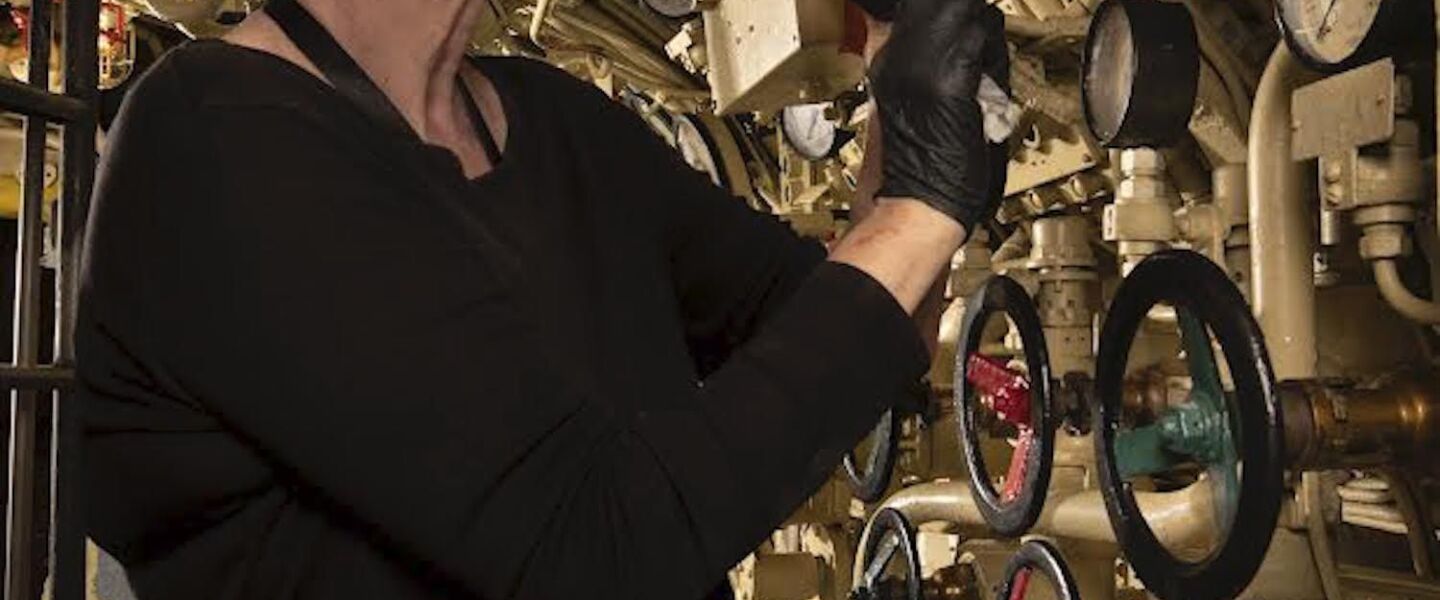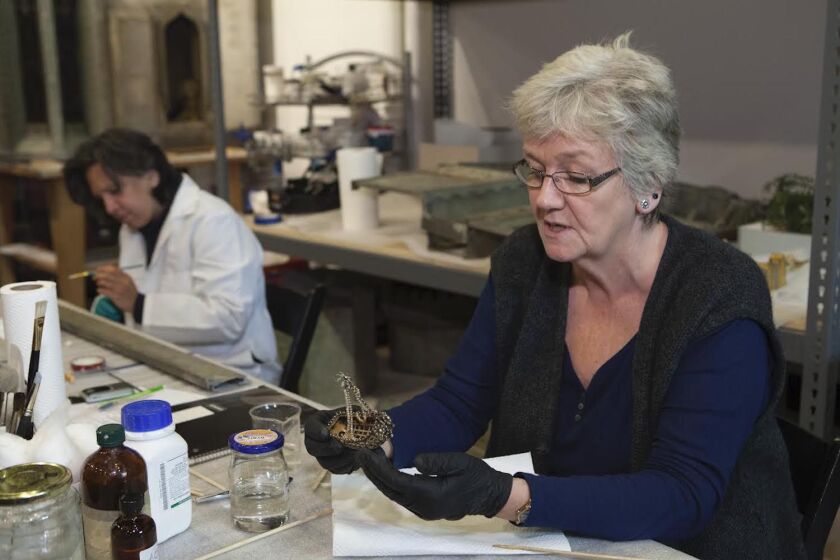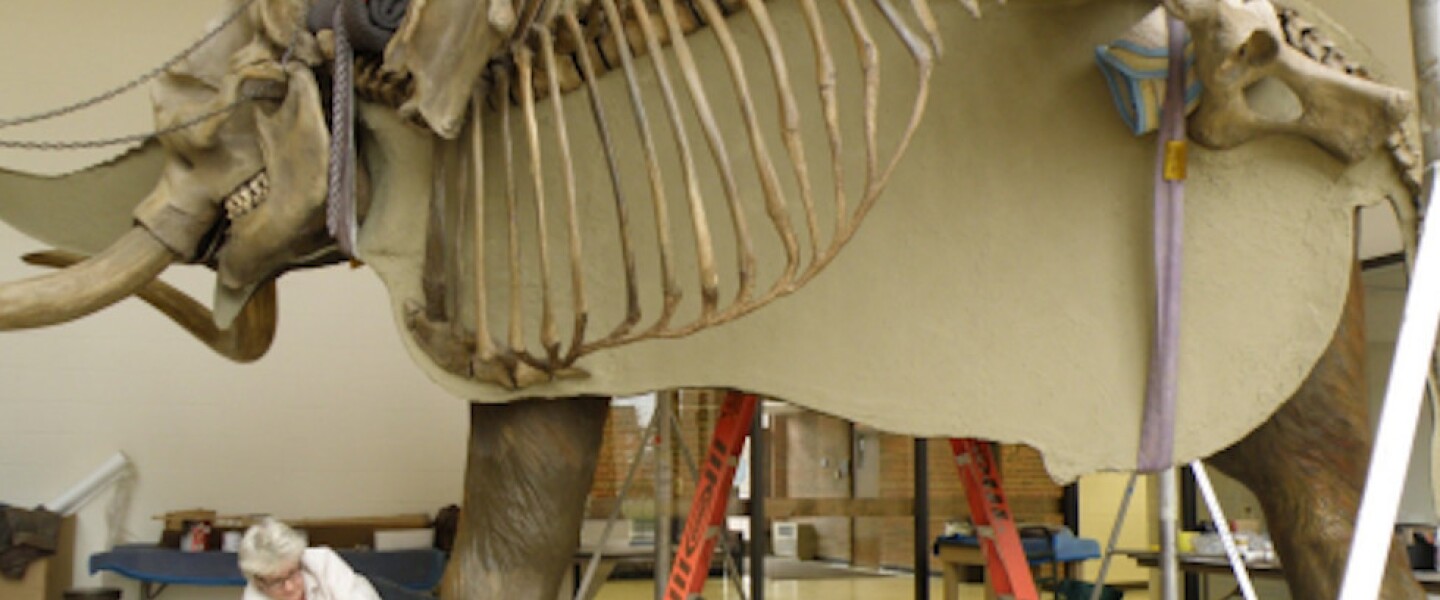When Jane Foley was beginning her career as a conservator of antiquities, she got assigned to spruce up the walls at Buckingham Palace.
She’d later tell the story of how she was up on a ladder one day, “looked down, and there was a nice old woman with a handbag looking up at me.”
It was Queen Elizabeth.
Her Majesty asked: “Are you cleaning the gilding?”
“Halfway up a ladder,” Ms. Foley told her family, “I attempted a curtsy and said, ‘Yes, ma’am, I am.’ ”
Ms. Foley, 71, who lived in Evanston and Wales, died of pancreatic cancer Oct. 10 at her home near the Welsh town of Builth Wells.
She was a renowned conservator who was called upon to preserve relics and objets d’art around the world, including some of the most beloved artifacts at Chicago’s museums.
Among them: the German U-505 World War II submarine at the Museum of Science and Industry. Captured by American forces in 1944, it’s the only German submarine on U.S. soil.

Jane Foley cleaned instruments, floors and decks of the captured U-505 Nazi submarine at the Museum of Science and Industry and removed corrosion from its propellers. She was skilled at removing old coatings and at matching the color of vintage paints.
JB Spector / Museum of Science and Industry ©2019
Her memories of chimney sweeps in her native England inspired her work on that, according to head curator Kathleen McCarthy. Ms. Foley modified chimney-sweep tools to clean the conning tower — the mini-tower in the middle of the sub, a space so cramped it can fit just than a ladder, a periscope tube, the top hatch and a seat the size of a bike saddle.
“She always came up with ingenious ways” to solve problems, McCarthy said.
Ms. Foley used to work on the sub after hours at the museum with fellow conservator Inez Litas, who was her wife and business partner.
“At night, it was very eerie to work there,” Litas said. “We’re thinking, ‘German soldiers walked here.’ ’’
Ms. Foley also spent months cleaning and restoring Colleen Moore’s Fairy Castle, the Museum of Science and Industry’s miniature palace. She painstakingly brushed away decades of dust that had settled on its 1,500 tiny objects and 19 rooms.
“Jane treated each individual room — mother-of-pearl, terra cotta, gold, platinum, silver, diamond–encrusted pieces of furniture and lighting,” said Margaret Schlesinger, a former museum curator.
“She approached every project with the skills of a scientist, an investigator, a problem solver, a detective — with MacGyver thrown in,” Schlesinger said.
At Wheaton College, she helped restore the Perry Mastodon, carefully removing layers of old shellac on the bones of the fossil found in a Glen Ellyn garden in the 1960s, according to Anna Weiss-Pfau of Third Coast Conservation, who worked on the project.
Ms. Foley was called in to help the Field Museum when it had to tear out wool carpeting due to a moth infestation that could have threatened historic textiles and taxidermied animals, said JP Brown, interim head of conservation.
All was going well until people realized that a section of carpet remained under the 2,600-year-old Egyptian sarcophagus of Pefthaukhonsu, a five-feet-by-nine-feet, black-granite crypt that weighed more than three tons.
Ms. Foley studied a structural crack in the sarcophagus and worked with Methods & Materials, a rigging and installation company, to devise a way to lift it.
”It was nerve-wracking,” Brown said.
But it worked.
“She wasn’t afraid of anything,” her wife said.
Chicago History Museum curator Holly Lundberg described Ms. Foley’s attitude this way: “We can do it!”
“She was not afraid to get dirty, to get down underneath things,” said Roger Machin, director of Methods & Materials.
A month before she died, Ms. Foley completed a plan advising the Block Museum of Art at Northwestern University on how to preserve its statues and sculpture garden.
“In Chicago, everyone knew Jane,” said Kristina Bottomley, assistant director of collections and exhibition management at the Evanston museum.
Ms. Foley’s remarkable career was all the more so because it began only in midlife. A single mother, she’d held jobs in England running a nanny agency and an art gallery. But she wasn’t happy, according to her daughter Clare Foley Gilliland. The gallery struggled. Their home was repossessed.
“She could have hit the floor then and never picked herself up,” her daughter said, “but she turned her life around.”
At 43, Ms. Foley enrolled at City & Guilds of London Art School to study conservation.
“We were massively proud of her,” her daughter said.
“It took an enormous amount of bravery,” said her sister Fiona Croft.
“As soon as she had a career she enjoyed, she was happy,” her daughter said.
Before finishing college, “She’d never been beyond Europe,” Foley Gilliland said.
Then, as her reputation grew, she was called on to travel the world for her work. In Kuwait, she catalogued antiquities for the United Nations. In England, she worked on the restoration of the stage and decorations for Shakespeare’s Globe theater. She also preserved weaponry and armor at the Tower of London and gilding and paint at St. Paul’s Cathedral.
In Chicago, she worked on sculptures at the Museum of Contemporary Art, 19th century Japanese panels at the Art Institute and the Lorado Taft “Recording Angel” statue at the University of Chicago.
At the Illinois Holocaust Museum in Skokie, she helped maintain a German railroad boxcar like those used to transport millions of Jews to death camps during World War II.
She also worked on a rare urn and other objects at the Frank Lloyd Wright Home and Studio in Oak Park.
Her wife said the Field Museum hired Ms. Foley to teach conservation techniques to Iraqi museum officials.
“Jane was very conscious and upset when sculptures, famous archaeological sites, etc. in the Middle East were destroyed by Isis,” she said.
Ms. Foley felt so strongly about this that, in 2019, despite an aversion to being onstage, she appeared in a performance piece about the destruction of antiquities — called “Atlas Unlimited (Acts V-VI)” — at the Logan Center gallery at the University of Chicago.
Her interest in preservation started early. Growing up near Warblington Castle in Hampshire, England, young Jane once found a couple of battered bronze lanterns on her family’s property.
“She renovated them beautifully, using all the right materials,” her sister said.
Twenty years ago, Ms. Foley was a conservator of stone, wall paintings and mosaics at the British Museum when it lent items to the Field Museum for a 2001 Cleopatra exhibition. She accompanied the treasures to the Field.
That’s where she met Litas, her future wife.
They went on to also work together at their companies Litas Liparini Restoration Studio of Evanston and Foley Conservation in Wales.
In addition to her wife, daughter and sister, Ms. Foley is survived by her brothers Patrick and Martin, step-siblings Sarah, Clare, Mandy and Joanna, stepchildren Christine and Alex and granddaughters Evie and Leia.
A funeral service is planned for 12:30 p.m. Tuesday at St Thomas à Becket Church in Hampshire.
From her gravesite, “You can see the house where she grew up, and you can see the window of her first bedroom,” her sister said.
She asked that her service feature the music of DeBussy’s Claire de Lune, the Mideast-inspired “Facing East” by Thievery Corporation and Moby’s “God Moving Over the Face of the Waters.”
Ms. Foley always cared about the planet, her daughter said, so she will be buried in an eco-friendly bamboo coffin. Tucked inside will be an antique, ivory-covered prayer book that her grandparents gave her, which she had beautifully conserved.









